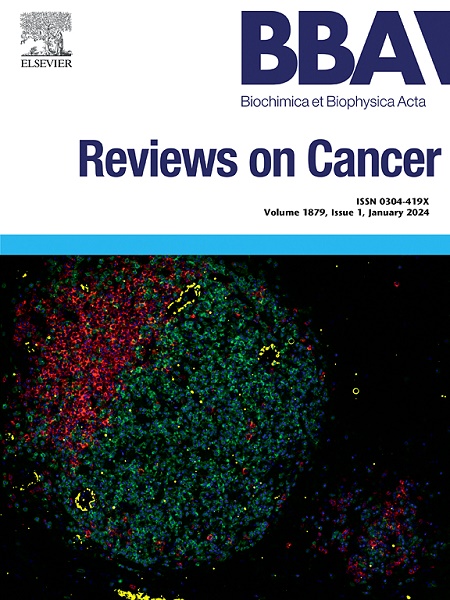cd39 - cd73 -腺苷轴:胰腺导管腺癌免疫逃避的主要调控因子和治疗靶点。
IF 9.7
1区 医学
Q1 BIOCHEMISTRY & MOLECULAR BIOLOGY
Biochimica et biophysica acta. Reviews on cancer
Pub Date : 2025-09-08
DOI:10.1016/j.bbcan.2025.189443
引用次数: 0
摘要
胰腺导管腺癌(PDAC)表现出对免疫治疗的持续耐药性,其5年生存率约为10% %。cd39 - cd73 -腺苷轴在PDAC中作为免疫逃避的关键介质出现,产生病理性升高的腺苷浓度,系统性地抑制抗肿瘤免疫。嘌呤能途径通过CD39和CD73外核酶连续水解ATP,产生腺苷,腺苷结合四种g蛋白偶联受体(A1, A2A, A2B, A3)来协调全面的免疫抑制。A2A和A2B受体通过cAMP-PKA信号介导主要的免疫抑制作用,抑制CD8+ T细胞和NK细胞的细胞毒性,同时增强调节性T细胞、髓源性抑制细胞和m2样肿瘤相关巨噬细胞。癌症相关成纤维细胞和肿瘤细胞参与腺苷的产生并响应其信号,建立自我强化的免疫抑制网络。目前的治疗策略显示出有希望的早期临床结果,多种CD73抑制剂、CD39拮抗剂和腺苷受体拮抗剂正在PDAC试验中进行评估。然而,关键的挑战仍然存在:CD73的非酶功能独立于腺苷的产生而促进化疗耐药,这解释了为什么酶抑制剂不能增强化疗敏感性。肿瘤内的空间腺苷梯度、受体特异性矛盾效应和AMP积累的代偿性耐药机制进一步使治疗靶向复杂化。结合腺苷途径抑制、检查点阻断、化疗和基质调节的多靶点方法显示出更高的疗效。未来的发展方向包括开发预测性生物标志物面板,优化组合序列,以及设计针对嘌呤能酶的酶和结构功能的抑制剂。了解这些复杂的相互作用为将腺苷途径从免疫抑制屏障转化为PDAC的治疗机会提供了基础。本文章由计算机程序翻译,如有差异,请以英文原文为准。
The CD39-CD73-adenosine axis: Master regulator of immune evasion and therapeutic target in pancreatic ductal adenocarcinoma
Pancreatic ductal adenocarcinoma (PDAC) exhibits persistent resistance to immunotherapy, with a 5-year survival rate around 10 %. The CD39-CD73-adenosine axis emerges as a critical mediator of immune evasion in PDAC, generating pathologically elevated adenosine concentrations that systematically suppress anti-tumor immunity. This purinergic pathway operates through sequential ATP hydrolysis by CD39 and CD73 ectonucleotidases, producing adenosine that engages four G-protein-coupled receptors (A1, A2A, A2B, A3) to orchestrate comprehensive immunosuppression. A2A and A2B receptors mediate the predominant immunosuppressive effects through cAMP-PKA signaling, inhibiting CD8+ T cell and NK cell cytotoxicity while enhancing regulatory T cells, myeloid-derived suppressor cells, and M2-like tumor-associated macrophages. Cancer-associated fibroblasts and tumor cells contribute to adenosine production and respond to its signaling, establishing self-reinforcing immunosuppressive networks. Current therapeutic strategies demonstrate promising early clinical results, with multiple CD73 inhibitors, CD39 antagonists, and adenosine receptor antagonists under evaluation in PDAC trials. However, critical challenges remain: CD73's non-enzymatic functions promote chemoresistance independently of adenosine production, explaining why enzymatic inhibitors fail to enhance chemotherapy sensitivity. The spatial adenosine gradient within tumors, receptor-specific paradoxical effects, and compensatory resistance mechanisms through AMP accumulation further complicate therapeutic targeting. Multi-targeted approaches combining adenosine pathway inhibition with checkpoint blockade, chemotherapy, and stromal modulation show enhanced efficacy. Future directions include developing predictive biomarker panels, optimizing combination sequences, and designing inhibitors targeting both enzymatic and structural functions of purinergic enzymes. Understanding these complex interactions provides the foundation for transforming the adenosine pathway from an immunosuppressive barrier into a therapeutic opportunity in PDAC.
求助全文
通过发布文献求助,成功后即可免费获取论文全文。
去求助
来源期刊

Biochimica et biophysica acta. Reviews on cancer
医学-生化与分子生物学
CiteScore
17.20
自引率
0.00%
发文量
138
审稿时长
33 days
期刊介绍:
Biochimica et Biophysica Acta (BBA) - Reviews on Cancer encompasses the entirety of cancer biology and biochemistry, emphasizing oncogenes and tumor suppressor genes, growth-related cell cycle control signaling, carcinogenesis mechanisms, cell transformation, immunologic control mechanisms, genetics of human (mammalian) cancer, control of cell proliferation, genetic and molecular control of organismic development, rational anti-tumor drug design. It publishes mini-reviews and full reviews.
 求助内容:
求助内容: 应助结果提醒方式:
应助结果提醒方式:


